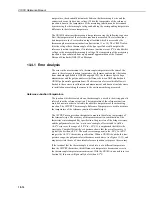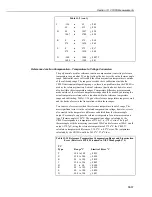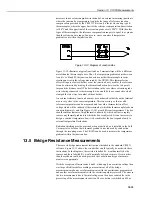
CR10X Reference Manual
13-8
R
o
, the source resistance, is not constant because R
b
varies from 0 to 10k
Ω
over
the 0 to 360 degree wind direction range. The source resistance is given by:
R
o
= R
d
+R
b
(R
s
-R
b
+R
f
)/(R
s
+R
f
)
= R
d
+R
b
(20k-R
b
)/20k
[12]
Note that at 360°, R
o
is at a maximum of 6k (R
b
=10k) and at 0°, R
o
is 1k (R
b
=0).
It follows that settling errors are less at lower direction values.
The value of R
b
for any direction D (degrees) is given by:
R
b
(kohms) = (10k)(D)/360
[13]
Equation 6 can be rewritten to yield the settling error of a rising signal directly in
units of degrees.
Error (degrees) = De-t/(R
o
(C
f
+C
w
L))
[14]
Equations 12, 13 and 14 can be combined to estimate the error directly in degrees
at various directions and lead lengths (see Table 13-3). Constants used in the
calculations are given below:
C
f
= 3.3nF
C
w
= 134pF/m Belden #8771 wire
t = 450µs
Table 13-3 Settling Error, in Degrees, for 024A Wind Direction Sensor
vs. Lead Length
Wind
- - - - - Error - - - - -
Direction
L=300m
L=155m
360
o
66
o
15
o
270
o
45
o
9
o
180
o
21
o
3
o
90
o
4
o
0
o
The values in Table 13-3 show that significant error occurs at large direction
values for leads in excess of 155m. Instruction 4 (Excite, Delay and Measure)
should be used to eliminate errors in these types of situations. Using a 10ms delay,
settling errors are eliminated up to lengths that exceed the drive capability of the
excitation channel (
≅
700m).
Other measurement errors are possible when using a potentiometer
windvane with a long cable. Please contact Campbell Scientific for
further information.
13.3.3 Transients Induced by Switched Excitation
Figure 13-9 shows a typical half bridge resistive sensor, such as Campbell
Scientific’s 107 Temperature Probe, connected to the CR10X. The lead wire is a
single-shielded pair, used for conducting the excitation (V
x
) and signal (V
s
) volt-
ages. When V
x
is switched on, a transient is capacitively induced in V
s
, the signal
voltage. If the peak transient level, V
eo
, is less than the true signal, V
so
, the
transient has no effect on the measurement. If V
eo
is greater than V
so
, it must
settle to the correct signal voltage to avoid errors.
Excitation transients are eliminated if excitation leads are contained
in a shield independent from the signal leads.
NOTE
NOTE
















































